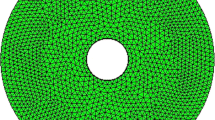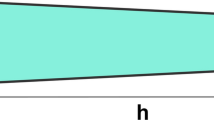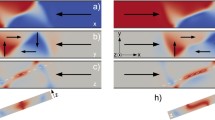Abstract
Dynamic susceptibility of thin truncated conical permalloy nanodisk with height 20 nm is simulated using micromagnetic simulations. Starting from a relaxed magnetic vortex state, the effect of tapering on the resonant modes is analyzed by changing the bottom radius (R = 50 nm to 100 nm) and top radius (r = 10 nm to R − 10 nm) of the conical nanodisk. When an in-plane excitation field pulse is applied, the lowest resonant peak frequency increases with increase in r. This mode is originated due to vortex core translation and the variation of the resonant peak with r is well explained using Thiele’s equation. Other resonant modes appear at higher excitation frequencies which are identified as azimuthal modes. When an out-of-plane excitation field is applied, all the spin wave modes appear to be axially symmetric. Appearance of new resonant modes and shifting of the resonant frequency is recorded by changing either of the parameter r or R for both the excitation field directions. The spatial distribution of FFT of magnetization at each resonant mode links the area of nanodisk that has maximum contribution to each mode and combining this with average center of magnetization perturbation, shifting of resonance frequency is explained successfully. The findings from this study prove that tunable resonant frequency can be achieved by tapering of truncated conical nanodisks.

















Similar content being viewed by others
References
Parkin S, Yang SH (2015) Memory on the racetrack. Nat Nanotechnol 10(3):195–198. https://doi.org/10.1038/nnano.2015.41
Dieny B, Prejbeanu IL, Garello K et al (2020) Opportunities and challenges for spintronics in the microelectronics industry. Nat Electron 3(8):446–459. https://doi.org/10.1038/s41928-020-0461-5
Cowburn R (2002) Magnetic nanodots for device applications. J Magn Magn Mater 242:505–511. https://doi.org/10.1016/S0304-8853(01)01086-1
Eichwald I, Bartel A, Kiermaier J et al (2012) Nanomagnetic logic: error-free, directed signal transmission by an inverter chain. IEEE Trans Magn 48(11):4332–4335. https://doi.org/10.1109/TMAG.2012.2196030
Liu J, Su D, Wu K et al (2020) High-moment magnetic nanoparticles. J Nanoparticle Res 22(3):1–16. https://doi.org/10.1007/s11051-020-4758-0
Merbouche H, Collet M, Evelt M et al (2021) Frequency filtering with a magnonic crystal based on nanometer-thick yttrium iron garnet films. ACS Appl Nano Mater 4(1):121–128. https://doi.org/10.1021/acsanm.0c02382
Guerra Y, Viana BC, Padron-Hernandez E (2022) FMR by micromagnetic simulation in modulated FeCo nanowires. J Supercond Nov Magn 35(3):825–831. https://doi.org/10.1007/s10948-021-06114-3
Saavedra E, Saez G, Diaz P et al (2019) Dynamic susceptibility of modulated magnetic nanowires. AIP Adv 9(6). https://doi.org/10.1063/1.5091813
Bisero D, Cremon P, Madami M et al (2011) Effect of dipolar interaction on the magnetization state of chains of rectangular particles located either head-to-tail or side-by-side. J Nanoparticle Res 13(11):5691–5698. https://doi.org/10.1007/s11051-011-0288-0
Krone P, Makarov D, Cattoni A et al (2011) Investigation of the magnetization reversal of a magnetic dot array of Co/Pt multilayers. J Nanoparticle Res 13(11):5587–5593. https://doi.org/10.1007/s11051-010-0123-z
Guimaraes AP (2009) Principles of nanomagnetism, vol 7. Springer, New York. https://doi.org/10.1007/978-3-319-59409-5
Mu C, Jing J, Dong J et al (2019) Static and dynamic characteristics of magnetism in permalloy oval nanoring by micromagnetic simulation. J Magn Magn Mater 474:301–304. https://doi.org/10.1016/j.jmmm.2018.11.049
XianYu ZN, Du A (2020) Dynamic susceptibility in torus nanoring with canted external dc magnetic field. J Magn Magn Mater 511:166,955. https://doi.org/10.1016/j.jmmm.2020.166955
Boust F, Vukadinovic N, Labbe S (2004) High-frequency susceptibility of soft ferromagnetic nanodots. J Magn Magn Mater 272:708–710. https://doi.org/10.1016/j.jmmm.2003.11.257
Vigo-Cotrina H, Guimaraes A (2021) Spin wave modes of nanoellipses with a magnetic radial vortex configuration. J Magn Magn Mater 518:167,377. https://doi.org/10.1016/j.jmmm.2020.167377
Taurel B, Valet T, Naletov VV et al (2016) Complete mapping of the spin-wave spectrum in a vortex-state nanodisk. Phys Rev B 93(18):184,427. https://doi.org/10.1103/PhysRevB.93.184427
Peng Y, Zhao G, Morvan F et al (2017) Dynamic micromagnetic simulation of the magnetic spectrum of permalloy nanodot array with vortex state. J Magn Magn Mater 422:57–60. https://doi.org/10.1016/j.jmmm.2016.08.060
Luo J, Zheng H, Chen W et al (2019a) Conical-shaped hexagonal barium ferrite nanodot arrays on an alumina substrate based on an ultrathin alumina mask method. J Magn Magn Mater 489:165,449. https://doi.org/10.1016/j.jmmm.2019.165449
Luo J, Zheng H, Deng J et al (2019b) Micromagnetic simulation of dynamic magnetic susceptibility and magnetostatic interaction fields of conical-shaped barium ferrite nanodot arrays. J Phys D Appl Phys 52(40):405,001. https://doi.org/10.1088/1361-6463/ab3137
Sahu R, Mishra AC (2022) Magnetization reversal and ground states in thin truncated conical nanodisks: analytical and micromagnetic modelling approach. J Magn Magn Mater 556:169,356. https://doi.org/10.1016/j.jmmm.2022.169356
Ma Y, Song C, Jin C et al (2019) Microwave-driven dynamic switching of the radial vortex in a nanodot by micromagnetic simulation. J Phys D Appl Phys 52(19):195,001. https://doi.org/10.1088/1361-6463/ab0356
Kumar D, Adeyeye A (2017) Techniques in micromagnetic simulation and analysis. J Phys D Appl Phys 50(34):343,001. https://doi.org/10.1088/1361-6463/aa7c04
Iacob N, Kuncser A, Comanescu C et al (2020) Optimization of magnetic fluid hyperthermia with respect to nanoparticle shape-related parameters: case of magnetite ellipsoidal nanoparticles. J Nanoparticle Res 22(6):1–10. https://doi.org/10.1007/s11051-020-04842-6
Schoberl J (1997) NETGEN an advancing front 2D/3D-mesh generator based on abstract rules. Comput Vis Sci 1(1):41–52. https://doi.org/10.1007/s007910050004
Renuka Balakrishna A, James RD (2021) A solution to the permalloy problem—a micromagnetic analysis with magnetostriction. Appl Phys Lett 118(21):212,404. https://doi.org/10.1063/5.0051360
Coey JMD (2001) Materials for spin electronics. Springer, Berlin, pp 277–297. https://doi.org/10.1007/3-540-45258-3_12
Bozorth RM (1993) Ferromagnetism. D. Van Nostrand Company
Valletta R, Guthmiller G, Gorman G (1991) Relation of thickness and some physical properties of nife thin films. J Vacuum Sci Technol A Vacuum Surf Films 9(4):2093–2098. https://doi.org/10.1116/1.577232
Wei J, Zhu Z, Song C et al (2016) Annealing influence on the exchange stiffness constant of permalloy films with stripe domains. J Phys D Appl Phys 49(26):265,002. https://doi.org/10.1088/0022-3727/49/26/265002
Sipr O, Mankovsky S, Ebert H (2019) Spin wave stiffness and exchange stiffness of doped permalloy via ab initio calculations. Phys Rev B 100(2):024,435. https://doi.org/10.1103/PhysRevB.100.024435
Venkat G, Venkateswarlu D, Joshi R et al (2018) Enhanced spin wave propagation in magnonic rings by bias field modulation. AIP Adv 8(5):056,006. https://doi.org/10.1063/1.5006576
Rao S, Rhensius J, Bisig A et al (2015) Time-resolved imaging of pulse-induced magnetization reversal with a microwave assist field. Sci Rep 5(1):1–8. https://doi.org/10.1038/srep10695
Fischbacher T, Franchin M, Bordignon G et al (2007) A systematic approach to multiphysics extensions of finite-element-based micromagnetic simulations: NMAG. IEEE Trans Magn 43 (6):2896–2898. https://doi.org/10.1109/TMAG.2007.893843
Baker A, Beg M, Ashton G et al (2017) Proposal of a micromagnetic standard problem for ferromagnetic resonance simulations. J Magn Magn Mater 421:428–439. https://doi.org/10.1016/j.jmmm.2016.08.009
McMichael RD, Stiles MD (2005) Magnetic normal modes of nanoelements. J Appl Phys 97(10):10J901. https://doi.org/10.1063/1.1852191
Djuhana D, Rohman L, Kim D (2017) Micromagnetic calculation of the dynamic susceptibility spectra in LSMO ferromagnetic nanopillars. J Magn 22(3):364–368. https://doi.org/10.4283/JMAG.2017.22.3.364
Ramachandran P, Varoquaux G (2011) Mayavi: 3D visualization of scientific data. Comput Sci Eng 13(2):40–51. https://doi.org/10.1109/MCSE.2011.35
Ahrens J, Geveci B, Law C (2005) Paraview: An end-user tool for large data visualization. Vis Handbook 717(8)
Ayachit U (2015) The paraview guide: a parallel visualization application. Kitware, Inc
Boust F, Vukadinovic N (2004) Micromagnetic simulations of vortex-state excitations in soft magnetic nanostructures. Phys Rev B 70(17):172,408. https://doi.org/10.1103/PhysRevB.70.172408
Feldtkeller E, Thomas H (1965) Struktur und energie von blochlinien in dunnen ferromagnetischen schichten. Phys der kondensierten Materie 4(1):8–14. https://doi.org/10.1007/BF02423256
Guslienko KY, Ivanov B, Novosad V et al (2002) Eigenfrequencies of vortex state excitations in magnetic submicron-size disks. J Appl Phys 91(10):8037–8039. https://doi.org/10.1063/1.1450816
Guslienko KY, Han X, Keavney D et al (2006) Magnetic vortex core dynamics in cylindrical ferromagnetic dots. Phys Rev Lett 96(6):067,205. https://doi.org/10.1103/PhysRevLett.96.067205
Park J, Crowell P (2005) Interactions of spin waves with a magnetic vortex. Phys Rev Lett 95(16):167,201. https://doi.org/10.1103/PhysRevLett.95.167201
Neudecker I, Perzlmaier K, Hoffmann F et al (2006) Modal spectrum of permalloy disks excited by in-plane magnetic fields. Phys Rev B 73(13):134,426. https://doi.org/10.1103/PhysRevB.73.134426
Guslienko KY, Slavin AN, Tiberkevich V et al (2008) Dynamic origin of azimuthal modes splitting in vortex-state magnetic dots. Phys Rev Lett 101(24):247,203. https://doi.org/10.1103/PhysRevLett.101.247203
Liu Y, Lake RK, Zang J (2018) Shape dependent resonant modes of skyrmions in magnetic nanodisks. J Magn Magn Mater 455:9–13. https://doi.org/10.1016/j.jmmm.2017.07.007
Heinonen O, Schreiber D, Petford-Long A (2007) Micromagnetic modeling of spin-wave dynamics in exchange-biased permalloy disks. Phys Rev B 76 (14):144,407. https://doi.org/10.1103/PhysRevB.76.144407
Saavedra E, Palma JL, Escrig J (2022) Dynamic susceptibility spectra of stadium-shaped and elliptical nanostructures. J Magn Magn Mater 541:168,493. https://doi.org/10.1016/j.jmmm.2021.168493
Khanal S, Sherpa P, Spinu L (2019) Study of static and dynamic properties of planar dumbbell shaped structure of Ni80Fe20. AIP Adv 9(12):125,030. https://doi.org/10.1063/1.5129760
Zaspel C, Wright ES, Galkin AY et al (2009) Frequencies of radially symmetric excitations in vortex state disks. Phys Rev B 80(9):094,415. https://doi.org/10.1103/PhysRevB.80.094415
Author information
Authors and Affiliations
Corresponding author
Ethics declarations
Conflict of interest
The authors declare no competing interests.
Additional information
Publisher’s note
Springer Nature remains neutral with regard to jurisdictional claims in published maps and institutional affiliations.
Rahul Sahu, Prerit Tandon and Amaresh Chandra Mishra contributed equally to this work.
Appendix A: Calculation of vortex mode frequency
Appendix A: Calculation of vortex mode frequency
Using Feldtkeller model, [41] the magnetization of the vortex state is modelled as
in which
Now, the gyrovector is represented in components of gyrocoupling tensor as
The antisymmetric gyrocoupling density tensor is calculated as
Substitute the above equations in Eq. A2 and by solving, we get
Therefore, the gyrovector is obtained by substituting Eqs. A6 in A1
Consider the vortex is shifted by a distance X along the x-axis, then the new centre is at (ϱ,φ) where as the original centre is at (ρ,ϕ) such that
The magnetization is rewritten as
Now, the exchange energy can be calculated by using
Using Eq. A8 and solving
By substituting the above equations in Eq. A9, we have
Let the integrand be considered as
Splitting the limits to consider the curved part of the truncated conical nanodisk
Thus, the exchange energy can be calculated by the summation of Eqs. A14 and A15.
The dipolar energy is given as
where the potential is
The demagnetization energy has no volume contribution, so we calculate the surface demagnetization energy and only the effect of curved surface is considered.
Projecting the area integral onto the x-y plane
By approximating
The radial part can be expressed as
where Jp are the first kind Bessel functions and using
But \(\delta \vec {M}(r^{\prime }) \) has only radial component
Substitute in Eq. A16 to calculate dipolar energy
We use the following equations to solve integration for z
Let the total dipolar energy δEdip = δEdip1 + δEdip2 + δEdip3, where
The summation of the above three equations gives the total demagnetization energy. Now, the total energy is calculated which is the algebraic sum of exchange energy and demagnetization energy that helps in finding the stiffness constant κ by utilizing W(X) = κX2. Therefore, the vortex mode frequency can be calculated by \( f=\frac {1}{2\pi }\frac {\kappa }{G} \).
Rights and permissions
Springer Nature or its licensor (e.g. a society or other partner) holds exclusive rights to this article under a publishing agreement with the author(s) or other rightsholder(s); author self-archiving of the accepted manuscript version of this article is solely governed by the terms of such publishing agreement and applicable law.
About this article
Cite this article
Kotti, A.P., Sahu, R., Tandon, P. et al. Tunable microwave susceptibility of thin truncated conical permalloy nanodisks : a micromagnetic investigation. J Nanopart Res 25, 41 (2023). https://doi.org/10.1007/s11051-023-05685-7
Received:
Accepted:
Published:
DOI: https://doi.org/10.1007/s11051-023-05685-7




